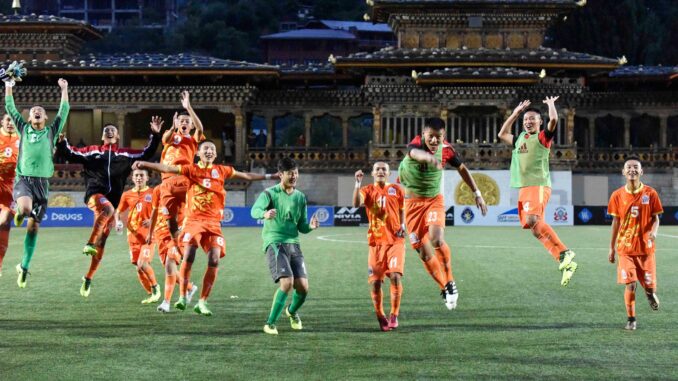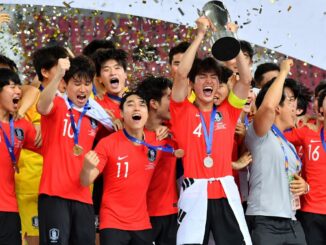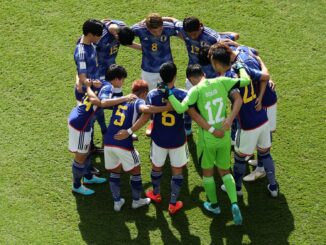
As the great and the good of association administrators prepare to descend on the 32nd AFC Congress this coming week, the power to change the course of development and opportunity across Asian football couldn’t be more in the balance.
With current discussions underway over the highly controversial “Super League” reform of the AFC Champions League, and the small matter of who (and potentially when) will host the next Asian Cup following China’s withdrawal over the weekend, the real long-term decision over the next couple of months instead hones in on the future of World Cup qualifying on the continent.
World Cup expansion requires a qualification rethink
The expansion of the World Cup in 2026 to 48 teams, sees the Asian selection increase in line, from four to eight direct slots alongside an extra spot via the intercontinental playoffs.
The increase does pose the question of how qualification will be determined moving forward, on the back of a broadly disappointing cycle, compounded by the ever-lingering COVID pandemic and repeatedly aired concerns over competitiveness.
In the coming month, the AFC are due to vote on the new combined World Cup/Asian Cup qualification schedule.
The two proposals on the table, seen by The Asian Game, provide identical final round determinants for those highly prized World Cup places.
Three groups of six, with the top two progressing directly to the World Cup, followed by third and fourth in each group entering a further round robin playoff, likely to be run in a condensed neutral hub format.
The two victors of this stage will pick up the final direct spots, with the runners up contesting for progression in the intercontinental playoffs.
A tad convoluted maybe, but a necessary evil to decide on an inflated allocation for World Cup qualification, one that the current format doesn’t exactly seem suited for.
While this latter stage format is now a mere inevitability (assuming the recent news coming out of China doesn’t cause further disruption), what instead is up for debate is the earlier rounds, arguably the most opinion-splitting aspect of the current format, the phase that the AFC have tinkered with the most over the years.
Round 1 – the forgotten stage
The art of balancing inclusion and competitiveness continues to elude the AFC, tending to err on the side of caution in favour of those who bemoan the lack of depth in Asian international football over the last decade.
Over the last few cycles, the AFC has opted to annex those ranked at the lower end of the international rankings to a quick-fire knockout round, effectively spelling an end to the four-year cycle for half of the teams involved, before the so-called elite have even started organising their first training camp.
In the latest edition, six teams were eliminated in the first round, way back in June 2019. Since then, not a single competitive game has been played between them. In comparison the likes of Japan, South Korea and Iran, have been involved in 18 matches apiece.
Mongolia, a team perpetually on the outside looking in, have gone from playing no post-Round 1 football in the last twelve years, to 11 matches in one single cycle on the run to World Cup 2022/Asian Cup 2023, thanks to their first ever preliminary round victory over Brunei.
The tightrope is precariously thin for those involved, a win or bust double-header at the start of the calendar that either offers inclusion and exposure for the long haul, or casts you off into the abyss for four long years.
The AFC’s new proposals set up a dilemma on what the future of international football looks like in Asia.
Proposal 1; stick with the same format, but this time raise the number of early exclusions to 11, or Proposal 2; merge the developing nations into the round-robin group stage proper from the very start.
Either teams are quickly struck off for another cycle or included from the start and given sufficient match experience to improve, feeding into the Asian Cup qualification tree if they are ultimately unsuccessful in their pursuit of progressing to the World Cup.
The positives, for those involved and for those with wider football development aspirations seem obvious; but the alternative view persists.
Given that 47, the total number of current AFC member associations, doesn’t cascade nicely down to 18 – the number proposed for the final round – as easily as 36, which is linked with Proposal 1, trimming off the fat early on will again be seen as an acceptable sacrifice for many, if the tournament’s design is saved.
AFC juggle the favour of its members
We’re only weeks on from widespread condemnation of the current format of the AFC Champions League, which adopts a similar best runners-up formula that would be required in World Cup qualifying if all 47 teams were to be included in an initial group stage.
The impact of such a format left many frustrated and often confused by the myriad of bizarre permutations that greeted the group stage’s completion, admittedly exasperated in the East by Shanghai Port’s withdrawal.
The benefits, however, of including more teams in the group stage was evident on the pitch; with greater achievement seen by the more peripheral names from developing member associations hailing from Malaysia, Jordan, India and Hong Kong.
In the main the AFC’s mission to raise standards across the continent has been demonstrated in their policy direction.
The expanded AFC Asian Cup in the United Arab Emirates back in 2019 saw the likes of Kyrgyzstan, Philippines and Yemen all make their finals debuts, subsequently seeing those teams narrow the gap on the so-called elite this past World Cup cycle.
But we’ve seen with recent AFC proposals, such as the consideration of a Super League type format to replace the only recently expanded Champions League, a desire to enhance the elite product has swung the emphasis back in the other direction.
In any given meeting of late, we hear AFC officials talk about bringing the continent together in one breath, followed by how they can “elevate the elite” in the next. Both objectives are clear and understandable, but unfortunately perceptibly linked.
Pakistan, lost to the abyss
For those potentially left behind by these initiatives, the fact remains that football rarely makes progress without simple and coordinated exposure to organised competitive play.
Pakistan, one of the case examples, who’s progress has been hampered over the last decade, in part due to federation upheaval, have not been helped by the lack of inclusion.
“(A lack of) proper football means very little incentive for warring factions in Pakistan to put football ahead of their petty political interests.” Ali Ahsan, editor of FootballPakistan.com, observes.
“The fans, players and stakeholders need to be shown the importance of international football and what it can do to help transform the local game. But for that, the national team will need to win a World Cup qualifier first or play major nations on a regular basis.”
The precarious nature of a single two-legged tie that defines the next four years has fast become a critical moment in whether local talent is fully realised. Ali explains: “The national team has been in the wilderness for such a long time that players have missed their peak years.”
“In the past, their national team performances have helped get them moves abroad for clubs in Nepal, Kyrgyzstan, Maldives etc. and also inspire a generation at home about making a pro club career. Imagine hosting top and second tier Asian nations in World Cup and Asian Cup qualifiers and how that can help promote the sport.”
The balance that the AFC are trying to achieve here is an unenviable one given the confederations’ current state. To please both ends of the footballing hierarchy – across a varied continent such as Asia – is nigh on impossible to achieve.
While nations such as Pakistan urge their confederation to increase participation, those at the other end of the spectrum continue to criticise the quality of competition in its current guise, let alone if expansion was fully embraced.
The long developmental journey starts with a splutter
The COVID pandemic hasn’t helped things, distilling down what used to be a unique and varied challenge of different venues and cultures, to a bland, neutral, soulless contest that created an almost carbon copy video game simulation that can’t compare to the real life competitive footballing experience.
The leading lights in Asia have often criticised the current format, for the lack of top-level experience it offers their international players; many of whom are travelling considerable distances back from playing their club football in Europe, to stroll effortlessly through World Cup qualification.
There are undoubtedly significant short-term impacts of extra inclusion, keenly felt in the last cycle through Iran’s 14-0 victory over Cambodia, Japan’s 14-0 win over Mongolia and South Korea’s 8-0 win over Sri Lanka, all that speak to a narrative that believes the gap between top and bottom in Asia is continuing to grow.
Yet this only represents a small sample of the larger developmental journey, after years, maybe decades of sitting stagnant on the periphery.
More exposure brings increased competition and in turn a positive uplift in results, as those three in particular experienced further into qualification.
Cambodia’s narrow 1-0 defeat to Bahrain and 1-1 draw with Hong Kong, Mongolia’s 1-0 wins over Kyrgyzstan and Myanmar and Sri Lanka’s narrow 3-2 reverse to Lebanon; all signs of tangible progress over a short time period.
Increased match play, however negative a heavy defeat can appear on paper, can be essential to push federations and governments to make significant developmental change.
Sri Lanka, a team that exited Round 1 of World Cup 2018 qualification in front of a mere handful of their own home support against Bhutan in 2015, subsequently made no progress over the following four-year period.
This time around, however, having progressed through Round 1 by default following Macau’s early withdrawal, put their football squarely back in the national spotlight; despite it being in the form of damaging defeats such as their 8-0 and 5-0 reversals to South Korea.
The reaction has been telling. Heading into the culmination of Asian Cup qualification, one that they remain part of despite their struggles, reform and improvement is now starting to be prioritised.
Linking up with Qatar’s Aspire project to install new coach Andy Morrison, Sri Lankan football, driven by renewed interest in the game has taken a positive step towards future development.
If this change in priorities can be instilled after one cycle of negative results, where could we be in two/three cycles when we start to see them actually compete?
Ranking mobility, how match experience can shift expectations
There are nations already firmly along this road including recent Asian Cup qualifiers Philippines and Palestine, and one of the revelations of early World Cup qualifying last time out, Tajikistan.
Despite relative stagnation over the last few years, the progress made by Indian football over the medium term shouldn’t be underestimated either.
Given the strength in feeling, that progression to Round 3 of World Cup qualification is now seen as a national disappointment, this truly illustrates how far they’ve come from the years of early exits and dwindling interest in a sport that has always played second fiddle, as observed by Naveen Peter of the Injury Time India podcast.
“Prior to 2015, India would find it hard to get meaningful matches against quality oppositions during an international window,” he said.
“But the overhaul of the qualifying system by the AFC has seen the national team engaged in competitive fixtures in most of the international windows.”
“This has seen the team benefit from the exposure and the performance at the 2019 AFC Asian Cup, which included a win over Thailand at the event and positive results against teams like China, Kyrgyzstan and Oman, which was reckoner of what the team can achieve with regular meaningful matches.”
India’s current slump, which as Naveen accepts is down to internal association difficulties rather than the opportunities it’s been granted, demonstrates how significantly the Asian football landscape fluctuates despite inclusion alone.
There is no promise that including more nations in the main stage of qualification will improve football in those countries overnight, but it crucially gives them the tools to do so.
Consistency is also needed however, as told through the story of Bhutan over the last two cycles.
Qualifiers for Round 2 in the 2018 World Cup campaign, Bhutan’s exposure to competitive football went from infrequent regional experience to long-term structured schedules facing nations as varied as Qatar and China, to Afghanistan and Maldives.
For Bhutan, characterised as one of the worst teams in the world at that time, progress was difficult, through heavy 15-0, 14-0, 12-0 defeats along the way. However, improvement was made by the end of the cycle, with a win and a draw against Bangladesh in the final round of Asian Cup qualification.
In their return the following cycle, despite a first leg home victory, Bhutan exited Round 1 at the hands of Guam, setting up a return to another four-year period of inaction and decline.
From the previous cycle where they were handed 16 World Cup and Asian Cup qualifiers, following their exit, Bhutan have only been able to schedule one friendly over the same time period.
How can long term development ever be built on such uncertain foundations?
When continental development isn’t the key priority
For some though, the appetite is admittedly not there, with progress seen as a long way off and with greater focus being put on regional success, rather than continental experience.
There is a growing acceptance from even those impacted by the changes that it might be better to reduce the David vs. Goliath challenges moving forward.
As influential observer of Southeast Asian football, Bear (from SEA) details: “One of the key problems and an inherent one is the perception that Southeast Asian football as a whole is still in the backwater from many peers in successful regions.
“The cost of organising one match, whether a friendly or a qualifier, or to send a squad overseas to play always come with high cost with returns almost always equaling to zero.”
He continues, “Southeast Asian football can take comfort that every two years (or every year, if you consider the SEA Games) that even a team eliminated in Round 1, there are always matches taking place even outside of the international calendar. AFF Cup, for example, gives minnows a chance to play four guaranteed group stage matches, which include two away matches.”
As Paul Williams proposed on site back in January, Southeast Asia in many ways is a continent within a continent when it comes to football.
The emphasis placed on success at the regional Suzuki Cup, and Southeast Asian Games tournaments, largely take precedence over World Cup qualification, as has been demonstrated by the recently ineffective campaigns by Thailand and Vietnam.
Focus on increased match exposure and improving yourselves against the rest of Asia becomes less and less important if you’re ultimately judged on success against your regional peers.
The appetite to face elite nations on a regular basis is going to become a little soul destroying if development isn’t prioritised.
The land of hope and opportunity
With the current schedule as it is, as I endorsed in my rebuttal of a proposed Asian Nations League last year, competition and opportunity is already equally spread across two stages in Asian qualification; Round 2 where the whole continent meets one another and Round 3 where you are pitched against teams of the same level.
The key oversight has always been Round 1, which needs to be integrated if all nations are to benefit from these two opportunities.
In both future proposals, the AFC are also considering a return to a model that adds in a third route of development; with the rekindling of the AFC Solidarity Cup, following its cycle absence due to COVID.
This is another useful tool in improving competitiveness and guaranteed football for those at the lower end of the international pyramid, a competition widely pushed for across the developing nations.
While I endorse its return, I do feel it could go further, possibly offering an Asian Cup finals birth to its victor, a similar incentive offered in Europe both at club (through the Europa League) and international level (through the Nations League).
As we head towards a clearer route forward for qualification, those in power need to consider their overarching remit to develop the Asian game, as outlined by AFC President Shaikh Salman as recently as this month: “our desire (is) to narrow the gap in Asian football, and to raise the level of competition across the continent.”
While it ticks all the boxes for a satisfying soundbite, it does leave a difficult circle to square, if in turn you’re cutting development off at the knees by retaining a Round 1 exit point that cuts loose the weakest teams in the confederation.
A glaring oversight as pointed out by Ali Ahsan of Pakistan Football: “ (the) 2026 World Cup (expansion) allows AFC the perfect opportunity to have an expanded, inclusive, and equitable qualification format. Excluding six or even 11 nations at the very first hurdle just isn’t fair on the development of those nations.”
With political, as well as footballing concerns at play, it’s anyone’s guess where the vote will finally take us. One certainty, the long-term fate of those eleven unfortunate nations, looks to be held tighter than ever in administrators’ hands.
Photo: Bhutan Football Federation




